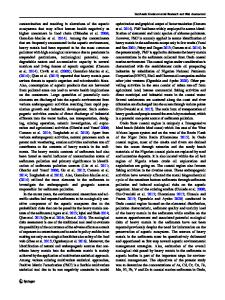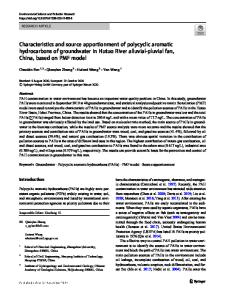Source apportionment of soil heavy metals in fluvial islands, Anhui section of the lower Yangtze River: comparison of AP
- PDF / 2,304,730 Bytes
- 14 Pages / 595.276 x 790.866 pts Page_size
- 70 Downloads / 414 Views
SOILS, SEC 3 • REMEDIATION AND MANAGEMENT OF CONTAMINATED OR DEGRADED LANDS • RESEARCH ARTICLE
Source apportionment of soil heavy metals in fluvial islands, Anhui section of the lower Yangtze River: comparison of APCS–MLR and PMF Jingtao Wu 1,2 & Andrew J. Margenot 3 & Xiao Wei 1 & Manman Fan 1 & Huan Zhang 1 & James L. Best 2 & Pengbao Wu 4 & Furong Chen 5 & Chao Gao 1 Received: 28 January 2020 / Accepted: 22 April 2020 # Springer-Verlag GmbH Germany, part of Springer Nature 2020
Abstract Purpose Source apportionment is a crucial step toward reducing heavy metal (HM) pollution within soils. Although comparison of receptor models to apportion sources is well-established in air and water pollution, it has been poorly implemented in evaluations of soil pollution. This study aimed (1) to assess the accumulation of As, Cr, Cu, Ni, Pb, Zn, Cd and Hg in soils of fluvial islands of the lower Yangtze River and (2) to apportion sources in a comparative evaluation of two receptor models, thus providing basic information for rational management of soil pollution in the study area. Materials and methods Soil samples were collected from representative fluvial islands in the Anhui section of the lower Yangtze River, China. A total of 207 topsoil samples (0–20 cm) were collected at a density of 1 sample per 1 km2 and 43 subsoil samples (150–180 cm) were collected at a density of 1 sample per 4 km2. The extent of pollution was estimated by determining total soil HM concentrations and calculating the geoaccumulation index (Igeo). The Local Moran’s index (LMI) was applied to detect the spatial distribution of HMs. Absolute principal component scores-multiple linear regression (APCS–MLR) and positive matrix factorization (PMF) were adopted to apportion the sources of HMs. Results and discussion The mean degree of contamination of the HMs can be ranked as follows: Cd > Hg > Cu > Ni > Cr > Zn > As > Pb. Average HM concentrations in topsoil were consistently higher than those in subsoil, with total HM concentrations varying between fluvial islands. Source apportionments suggested that the particle size effect was the dominant factor (59.3%) in the APCS–MLR model, whereas in the PMF model, calcium minerals played the most important role (50.2%). Concentrations of Cr and Ni were mainly related to the particle size effect, whereas concentrations of As, Cu, Pb and Zn were mainly related to the particle size effect, fixation by calcium minerals and atmospheric deposition from mining activities. The primary source for Cd anomalies was associated with calcium minerals and atmospheric deposition, whereas the accumulation of soil Hg was mainly driven by coal combustion. Conclusions This study indicated there was no extensive HM contamination in the study area except for Cd. Compared with APCS–MLR, PMF provided an optimal reconstruction of HM concentrations in soils. Thus, the PMF model could be applied to soils for HM pollution management in areas with multiple emission sources. Responsible editor: Kitae Baek Electronic supplementary material
Data Loading...











